In June, eighteen intrepid volunteers traveled to Scotland to help conserve a 1912 timber glasshouse on the ancient Burgie Estate. The task was not easy, but it seemed straightforward: Repair and clean the timber framing, paint and prime it, then replace the missing glass panes to restore its former beauty and function. In spite of the occasionally “dreich” Scottish weather, our “AstraGals” as they christened themselves, restored beauty to the old timber structure, and got the frame and the historic cast iron sanded, painted, and water-tight.
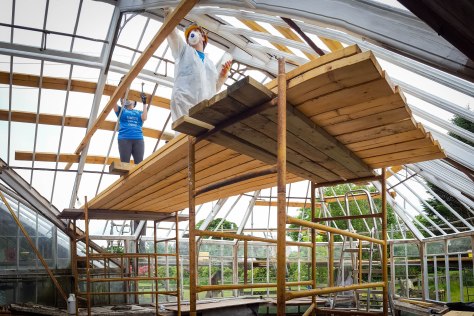
Volunteer crew hard at work up on the scaffold!
But when eighteen people spend two weeks up-close and personal with a building, you’re bound to find some unexpected surprises…
All of the things we found challenged our ideas and preconceptions about what a historic greenhouse was “supposed” to look like. At first we didn’t look past the surface: everything was painted a crumbling, flaming white, which dovetailed easily with our own aesthetic that it was probably a crisp, glowing structure all of gleaming white paint and glass. But as soon as the first paint layers came off, it became clear this was not the whole story….
It began on Day One with the cast iron gutters, which were covered in peeling white paint and needed to be sanded down before being repaired and repainted. Within a few minutes, the power-sanders had penetrated the white paint and all the rust to reveal… a layer of deep green! This was particularly exciting because the other intact cast iron elements in the interior.. are also painted green. So now we have the idea that the green ventilator levers and brackets aren’t just an accent colour – we’re getting evidence of an actual paint scheme working within the greenhouse.
We were in two minds about the green thing. The trouble was, the green was the absolute bottom coat of all the layers. Generally, ironwork is and was painted with a priming coat of red lead paint, prior to the exterior layers being added. But here, we had to grapple with the question of whether perhaps for whatever reason, they used green paint to prime it, meaning that the visible layers would still have been white. OR, that perhaps the original installers cut some corners and didn’t prime it at all but painted the decorative green straight on.
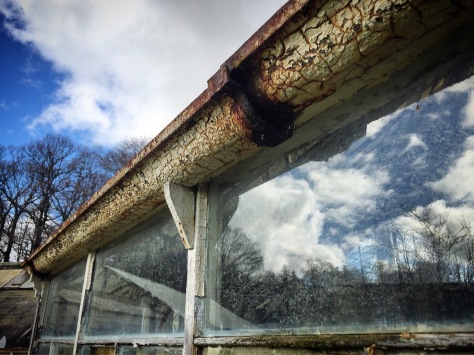
The poor gutters – they do look white though, don’t they?
The glasshouse also has a decorative cast-iron finial on the roof ridge of the central house (there were formerly two matching finials, but one was stolen long ago…), and when we prised it off its base and started sanding down its white paint and rust, guess what we found… More green! Curiouser and curiouser…
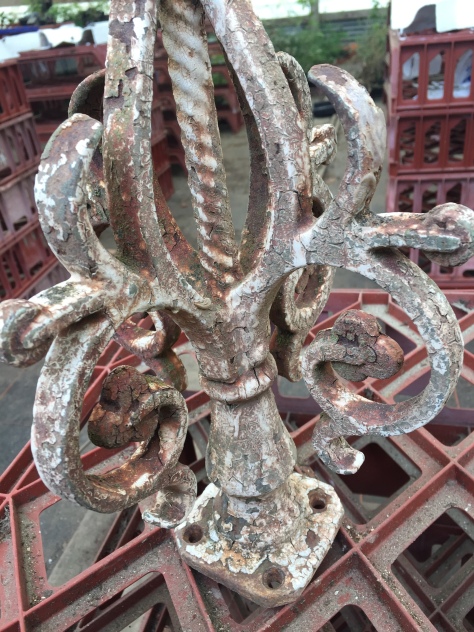
How many layers can you spot…?
Our volunteers spent two solid weeks face to face with the timber structure, sanding, chiseling, and repairing every spot they could reach, so it’s no surprise they picked up on things a casual observer might have passed right by. The glasshouse has stood for over a hundred years, and it’s definitely been repainted at least once in its lifetime. But, in some harder-to-reach corners, we were able to spot patches of what must have been the original paint – a very pale green! Now before we get carried away on the idea that the entire greenhouse was actually, well, green, I’m fairly certain that this was the original white lead paint that has aged to grey that just happens to have a greenish hue. Lead paints do tend to go greyer and paler as they age, as lead paint ages differently from modern oil or latex-based paints which crack. Lead-based paints powder away into a fine dust. So, for example, a door that was originally red would after a hundred years be much closer to pink.
Another exciting find was a decorative motif that still survived on some of the doors. Based on the flecks of paint still left, this curved ornament around the handles was originally a deep maroon, and even where the paint doesn’t survive well the outline of the motif is still clearly visible on most of the doors, indicating that it was pretty much ubiquitous throughout the glasshouse. It seemed a curious but distinctive feature, and when we mentioned it to Hamish, the owner, he told us that the Burgie Estate colour was, in fact, maroon.
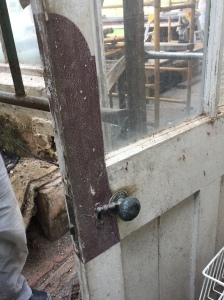
These maroon motifs were on almost every door in the greenhouse!
So there we had it, that little motif, that could so easily have been overlooked and carelessly sanded away, was a little piece of the original pride of Alexander Thompson’s new house and gardens. Just a little touch added, to say “Here I am – this beautiful building is mine.”
While the jury is still out on the original colour of the gutters and finial, the next conservation session definitely has plans to restore the maroon motifs to the doors. Paint samples were taken from various parts of the greenhouse to see if examination under a microscope revealed anything that our eyes couldn’t see, and I’m still slowly researching whether the green paint is more likely an exterior coat, or just a priming coat.
Another curious feature which I must have looked at a hundred times but never thought about, was the presence of little pulley wheels attached to certain parts of the greenhouse. Our brilliant volunteers theorised they could have belonged to adjustable blinds, which were sometimes used at greenhouses to provide shade in too-sunny conditions (in Scotland, seriously…?). This sounded plausible enough to me, though I didn’t know much about it, until a week later it turned out the AstraGals were right on the money!
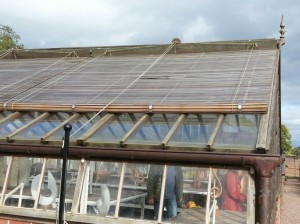
An example of how a pulley and blind system would have looked.
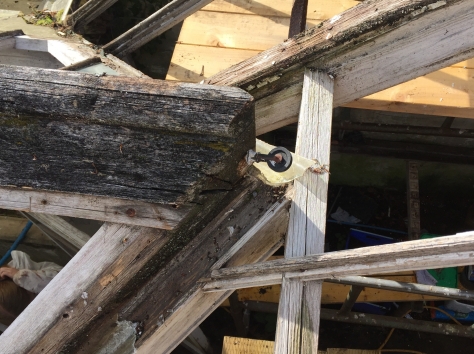
One of the “mystery” pulleys identified by our volunteers.
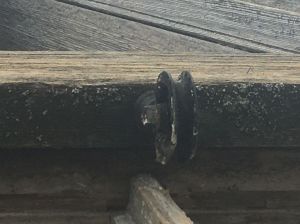
Close up!
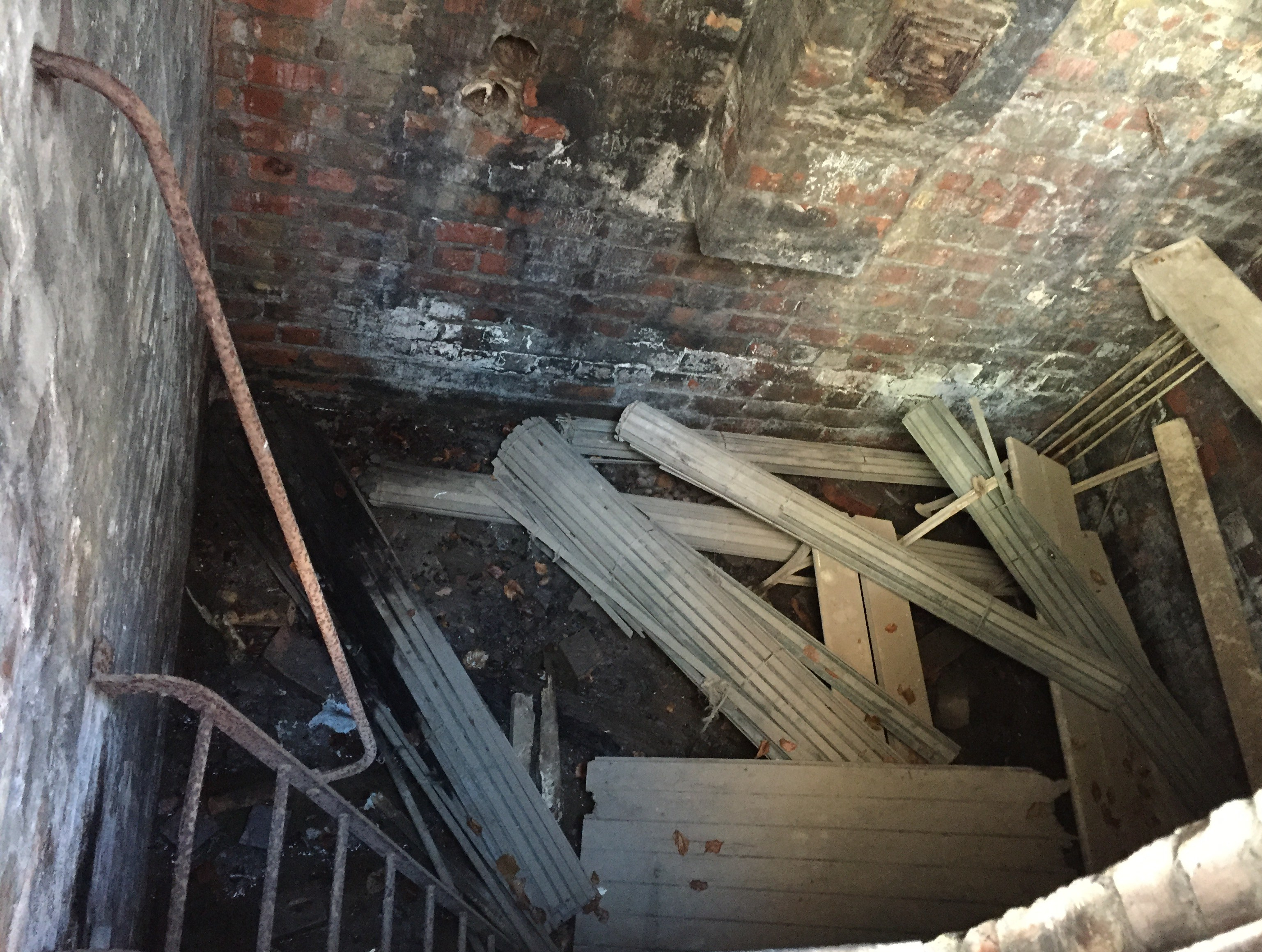
They don’t look like much, and it looks like someone tried to burn them, but I’m almost positive these are our blinds!
You see, down in the old boiler room are some rather strange-looking objects, that look like they’ve been thrown down there as a pile of old rubbish. I’d seen them a dozen times, but never wondered much about them, but once the seed about “greenhouse blinds” had been planted in my head… It suddenly clicked. Not only did we have the pulleys as evidence for the blinds, we actually had the blinds themselves sitting down in the boiler room all this while! This is incredible not just because we now know for certain that there were blinds, but now we even know precisely what they looked like and what they were made of. Until we can go down and rescue them and see what state they’re in, we won’t know whether they’re salvageable to actually re-install them. But maybe someday, when we find the expertise and/or a bit of funding, we can recreate the blinds to their original historic appearance. Gotta keep dreaming…!
[…] experience, Adventure in Preservation team members will build on the skills they learned while repairing and re-glazing the nearby Burgie glasshouse, where conservation work began in […]